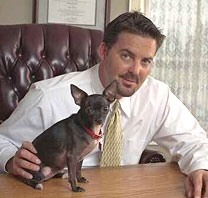| |
How to treat and prevent this
dangerous condition...
 In simple terms,
heatstroke occurs when a dog loses its natural ability to regulate its body temperature. Dogs
don't sweat all over their bodies the way humans do. Canine body temperature is primarily
regulated through respiration (i.e.panting). If a dog's respiratory tract cannot evacuate heat
quickly enough, heatstroke can occur. Robert Newman, a recognised authority on American animal
law, explains about heatstroke in dogs and what you can do about this life-threatening and
often fatal problem. In simple terms,
heatstroke occurs when a dog loses its natural ability to regulate its body temperature. Dogs
don't sweat all over their bodies the way humans do. Canine body temperature is primarily
regulated through respiration (i.e.panting). If a dog's respiratory tract cannot evacuate heat
quickly enough, heatstroke can occur. Robert Newman, a recognised authority on American animal
law, explains about heatstroke in dogs and what you can do about this life-threatening and
often fatal problem.
To know whether or not your dog is suffering from heatstroke - as
opposed to merely heat exposure - it's important to know the signs of heatstroke.
A dog's normal resting temperature is about 100.5 to 102.5 degrees
Fahrenheit. Once a dog's temperature rises above 105 degrees, physiological changes start to
take place, and the dog begins to experience the effects of heatstroke. At 106 - 108 degrees,
the dog begins to suffer irreversible damage to the kidneys, liver, gastrointestinal tract,
heart and brain.
If a dog is experiencing heatstroke, you may observe:-
- Excessive panting
- Hyperventilation
- Increased salivation
- Dry gums that become pale, grayish and tacky
- Rapid or erratic pulse
- Weakness
- Confusion
- Inattention
- Vomiting
- Diarrhoea
- Possible rectal bleeding
If the dog continues to overheat, breathing efforts become slowed
or absent, and finally, seizures or coma can occur.
The amount of damage a dog sustains when stricken with heatstroke
depends on the magnitude and duration of the exposure. The longer and more severe the exposure,
the worse the damage will be.
What to do?
- Pay attention to your dog. Recognising the symptoms of
heatstroke and responding quickly is essential for the best possible outcome.
- Get into the shade. If you think your dog is suffering from
heatstroke, move it into a shaded area and out of direct sunlight. Apply cool water to the
inner thighs and stomach of the dog, where there's a higher concentration of relatively
superficial, large blood vessels. Apply cool water to the foot pads, as well.
- Use running water. A faucet or hose is the best way to wet
down your dog's body. Never submerge your dog in water, such as in a pool or tub - this
could cool the dog too rapidly, leading to further complications, including cardiac arrest
and bloating.
- Use cool - not cold - water. Many people make the mistake of
using cold water or ice to cool the dog. When faced with a dog suffering from heatstroke,
remember that the goal is to cool the dog. Using ice or extremely cold water is actually
counterproductive to this process because ice and cold water cause the blood vessels to
constrict, which slows blood flow, thus slowing the cooling process.
- Don't cover the dog. One of the keys to successfully cooling
your dog is ensuring the water being placed on the dog can evaporate. Never cover an
overheated dog with a wet towel or blanket. This inhibits evaporation and creates a sauna
effect around your dog's body. Likewise, don't wet the dog down and put it into an enclosed
area, such as a kennel. Any air flow during the cooling process is helpful in reducing the
dog's body temperature.
- Sitting with the wet dog in a running car with the air
conditioner blowing is an ideal cooling situation. Keep the dog moving. It's important to
try to encourage your dog to stand or walk slowly as it cools down. This is because the
circulating blood tends to pool in certain areas if the dog is lying down, thus preventing
the cooled blood from circulating back to the core.
- Allow the dog to drink small amounts of water. Cooling the
dog is the first priority. Hydration is the next. Don't allow the dog to gulp water.
Instead, offer small amounts of water that's cool, but not cold. If the dog drinks too much
water too rapidly, it could lead to vomiting or bloat.
- Avoid giving human performance drinks. Performance beverages
designed for humans are not recommended because they are not formulated with the canine's
physiology in mind. If you can't get an overheated dog to drink water, try offering
chicken- or beef-based broths.
See a veterinarian
Once your dog's temperature begins to drop, cease the cooling efforts and bring the
dog to a veterinarian as soon as possible. Your dog's temperature should be allowed to slowly
return to normal once cooling has begun. A dog that's cooled too quickly may become
hypothermic.
Even if your dog appears to be fully recovered, the veterinarian
needs to check to determine if the heatstroke caused any damage to your dog's kidneys and
liver. The effects of heatstroke can continue for 48-72 hours longer, even if your dog appears
normal.
William Grant, DVM, a veterinarian for 20 years and former
president of the Southern California Veterinary Medical Association, has treated hundreds of
cases of heatstroke, ranging from mild to fatal. According to Grant, the most common cause of
death following heatstroke is disseminated intravascular coagulopathy (blood coagulating
throughout the body), or DIC, which can occur hours or days after the heatstroke episode. DIC
can also be caused by pyometra or septicemia, but Grant says heatstroke is the most common
cause.
'Once a dog develops DIC, it may bleed in the thorax, abdomen,
nose and intestine. After the blood-clotting factors are consumed, there is an inability of
the blood vessels to prevent leaking; the condition is almost always fatal." For this reason,
follow-up veterinary care is essential following a heatstroke episode, even if your dog seems
to be completely fine.'
Prevention is the best medicine
The best treatment for heatstroke is prevention. Especially during the summer
months, it's essential to be aware of the potential for heatstroke. Knowing the signs of
heatstroke, and taking the necessary steps to prevent it, will ensure your dog can have a safe
and active life year-round.
 About the
author... About the
author...
Robert Newman is an attorney in private practice in Santa Ana, California. In
addition to Criminal Defense and Family Law matters, Robert's practice focuses on civil
litigation involving animals. He is recognised as a leading authority on animal law and has
been named a lifetime member of The National Registry of Who's Who Among American Lawyers. He
has lectured at UCLA Law School and California Western School of Law. He shares his office with
his Chihuahua, Ruben, who is quite an accomplished agility dog in his own right.
Robert began competing in agility a few years ago with his
Chihuahua, Ruben. Soon he was hooked, and it wasn't long before his weekends were planned
around whichever agility trial was taking place. He retired Ruben at 7 years old, but around
that time his Border Collie, Torque, decided disc-dog competition was his niche. For a period
of time, that was the dog sport that occupied my weekends.
When his Pharaoh Hound Logan joined the family, he had the
opportunity to try dog sports he had not yet experienced. It started out innocently enough with
conformation events, but while working on conformation, he decided to try Logan in lure
coursing. Logan turned out to be a natural, and has been awarded multiple Best-in-Field titles.
First published 2 July 2009
| |
|